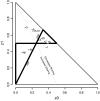High-density single nucleotide polymorphism genome-wide linkage scan for susceptibility genes for diabetic nephropathy in type 1 diabetes: discordant sibpair approach
- PMID: 18559660
- PMCID: PMC2518505
- DOI: 10.2337/db07-1086
High-density single nucleotide polymorphism genome-wide linkage scan for susceptibility genes for diabetic nephropathy in type 1 diabetes: discordant sibpair approach
Abstract
Objective: Epidemiological and family studies have demonstrated that susceptibility genes play an important role in the etiology of diabetic nephropathy, defined as persistent proteinuria or end-stage renal disease (ESRD) in type 1 diabetes.
Research design and methods: To efficiently search for genomic regions harboring diabetic nephropathy genes, we conducted a scan using 5,382 informative single nucleotide polymorphisms on 100 sibpairs concordant for type 1 diabetes but discordant for diabetic nephropathy. In addition to being powerful for detecting linkage to diabetic nephropathy, this design allows linkage analysis on type 1 diabetes via traditional affected sibpair (ASP) analysis. In weighing the evidence for linkage, we considered maximum logarithm of odds score (maximum likelihood score [MLS]) values and corresponding allelic sharing patterns, calculated and viewed graphically using the software package SPLAT.
Results: Our primary finding for diabetic nephropathy, broadly defined, is on chromosome 19q (MLS = 3.1), and a secondary peak exists on chromosome 2q (MLS = 2.1). Stratification of discordant sibpairs based on whether disease had progressed to ESRD suggested four tertiary peaks on chromosome 1q (ESRD only), chromosome 20p (proteinuria only), and chromosome 3q (two loci 58 cm apart, one for ESRD only and another for proteinuria only). Additionally, analysis of 130 ASPs for type 1 diabetes confirmed the linkage to the HLA region on chromosome 6p (MLS = 9.2) and IDDM15 on chromosome 6q (MLS = 3.1).
Conclusions: This study identified several novel loci as candidates for diabetic nephropathy, none of which appear to be the sole genetic determinant of diabetic nephropathy in type 1 diabetes. In addition, this study confirms two previously reported type 1 diabetes loci.
Figures



Similar articles
-
Genome-wide scan for type 1 diabetic nephropathy in the Finnish population reveals suggestive linkage to a single locus on chromosome 3q.Kidney Int. 2007 Jan;71(2):140-5. doi: 10.1038/sj.ki.5001933. Epub 2006 Oct 4. Kidney Int. 2007. PMID: 17021601
-
Genome-wide association scan for diabetic nephropathy susceptibility genes in type 1 diabetes.Diabetes. 2009 Jun;58(6):1403-10. doi: 10.2337/db08-1514. Epub 2009 Feb 27. Diabetes. 2009. PMID: 19252134 Free PMC article.
-
Major susceptibility locus for nephropathy in type 1 diabetes on chromosome 3q: results of novel discordant sib-pair analysis.Diabetes. 1998 Jul;47(7):1164-9. doi: 10.2337/diabetes.47.7.1164. Diabetes. 1998. PMID: 9648845
-
Evidence for different susceptibility genes for proteinuria and ESRD in type 2 diabetes.Adv Chronic Kidney Dis. 2005 Apr;12(2):155-69. doi: 10.1053/j.ackd.2005.02.002. Adv Chronic Kidney Dis. 2005. PMID: 15822051 Review.
-
Assessing genetic susceptibility to diabetic nephropathy.Nephrology (Carlton). 2005 Oct;10 Suppl:S17-21. doi: 10.1111/j.1440-1797.2005.00451.x. Nephrology (Carlton). 2005. PMID: 16174281 Review.
Cited by
-
Insights to the genetics of diabetic nephropathy through a genome-wide association study of the GoKinD collection.Semin Nephrol. 2010 Mar;30(2):126-40. doi: 10.1016/j.semnephrol.2010.01.004. Semin Nephrol. 2010. PMID: 20347642 Free PMC article. Review.
-
Modifier gene study of meconium ileus in cystic fibrosis: statistical considerations and gene mapping results.Hum Genet. 2009 Dec;126(6):763-78. doi: 10.1007/s00439-009-0724-8. Hum Genet. 2009. PMID: 19662435 Free PMC article.
-
Effects of MCF2L2, ADIPOQ and SOX2 genetic polymorphisms on the development of nephropathy in type 1 Diabetes Mellitus.BMC Med Genet. 2010 Jul 28;11:116. doi: 10.1186/1471-2350-11-116. BMC Med Genet. 2010. PMID: 20667095 Free PMC article.
-
Successes achieved and challenges ahead in translating biomarkers into clinical applications.AAPS J. 2010 Sep;12(3):243-53. doi: 10.1208/s12248-010-9182-4. Epub 2010 Mar 16. AAPS J. 2010. PMID: 20232184 Free PMC article.
-
Human genetics of diabetic vascular complications.J Genet. 2013 Dec;92(3):677-94. doi: 10.1007/s12041-013-0288-1. J Genet. 2013. PMID: 24371189 Review.
References
-
- Parving HH, Mauer M, Ritz E: Diabetic nephropathy. In Brenner and Rector's The Kidney. 7th ed. Brenner BM, Ed. Philadelphia, Elsevier,2004. , p.1777 –1818
-
- Seaquist ER, Goetz FC, Rich S, Barbosa J: Familial clustering of diabetic kidney disease: evidence for genetic susceptibility to diabetic nephropathy. N Engl J Med 320 :1161 –1165,1989 - PubMed
-
- Borch-Johnsen K, Norgaard K, Hommel E, Mathiesen ER, Jensen JS, Deckert T, Parving HH: Is diabetic nephropathy and inherited complication? Kidney Int 41 :719 –722,1992 - PubMed
-
- Quinn M, Angelico MC, Warram JH, Krolewski AS: Familial factors determine the development of diabetic nephropathy in patients with IDDM. Diabetologia 39 :940 –945,1996 - PubMed
-
- The Diabetes Control and Complications Trial Research Group: Clustering of long-term complications in families with diabetes in the Diabetes Control and Complications Trial. Diabetes 46 :1829 –1839,1997 - PubMed
Publication types
MeSH terms
Grants and funding
LinkOut - more resources
Full Text Sources
Medical
Molecular Biology Databases
Research Materials

